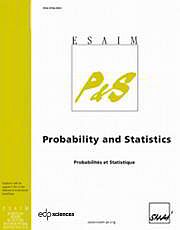Article contents
An application of multivariate total positivity topeacocks
Published online by Cambridge University Press: 10 October 2014
Abstract
We use multivariate total positivity theory to exhibit new families of peacocks. As theauthors of [F. Hirsch, C. Profeta, B. Roynette and M. Yor, Peacocks and associatedmartingales vol. 3. Bocconi-Springer (2011)], our guiding example is the resultof Carr−Ewald−Xiao [P. Carr, C.-O. Ewald and Y. Xiao,Finance Res. Lett. 5 (2008) 162–171]. We shall introducethe notion of strong conditional monotonicity. This concept is strictly more restrictivethan the conditional monotonicity as defined in [F. Hirsch, C. Profeta, B. Roynette and M.Yor, Peacocks and associated martingales, vol. 3. Bocconi-Springer (2011)] (see also [R.H.Berk, Z. Wahrscheinlichkeitstheorie und Verw. Gebiete 42(1978) 303–307], [A.M. Bogso, C. Profeta and B. Roynette, Lect. Notes Math.Springer, Berlin (2012) 281–315.] and [M. Shaked and J.G. Shanthikumar,Probab. Math. Statistics. Academic Press, Boston (1994)].). There aremany random vectors which are strongly conditionally monotone (SCM). Indeed, we shallprove that multivariate totally positive of order 2 (MTP2) random vectors are SCM. As aconsequence, stochastic processes with MTP2 finite-dimensional marginals are SCM. This familyincludes processes with independent and log-concave increments, and one-dimensionaldiffusions which have absolutely continuous transition kernels.
Keywords
- Type
- Research Article
- Information
- Copyright
- © EDP Sciences, SMAI 2014
References
- 2
- Cited by


